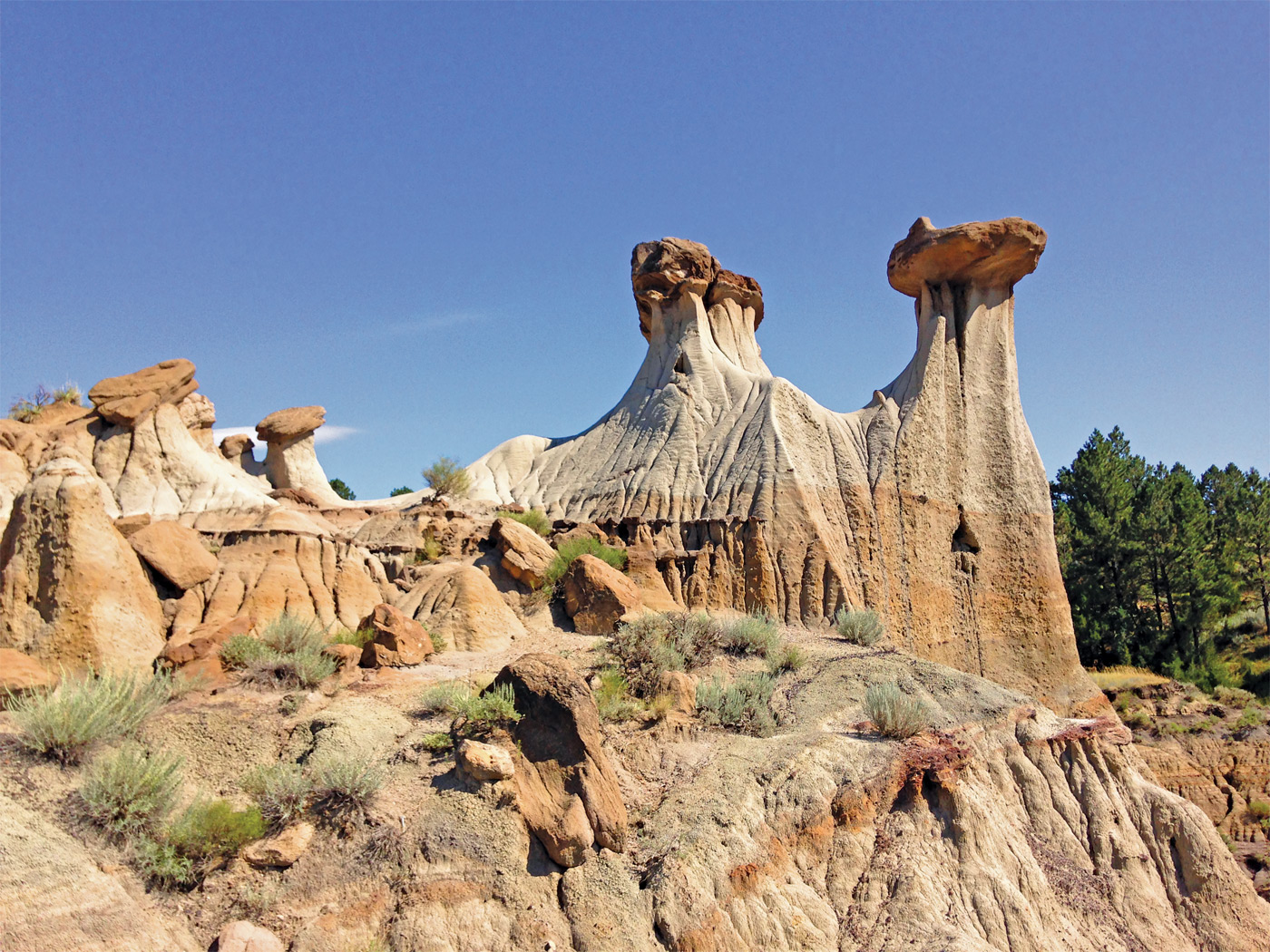It was billed as a major disaster film about a serious subject. The movie The Day after Tomorrow describes the effects of global warming at a breathtaking pace.1-3 Global warming triggers the collapse of the Antarctic ice sheet beneath a team of polar scientists. In chain-reaction-like consequences, the collapse sends a 100-foot tsunami across Manhattan before the city is frozen in ice. Super-tornadoes demolish Los Angeles, large hail knock people out in Tokyo, and New Delhi is buried in snow. Three vast, hurricane-like storms cover the Northern Hemisphere. Temperatures plummet 18°F per second to freeze people solid. Global warming ends up flash freezing the planet into the next ice age. The ice sheets move so fast that a man cannot outrun them. People in the northern United States are frozen, while those living in the south, in a reversal of political roles, plead for refugee status in Mexico to escape the cold in exchange for forgiveness of all Latin American debt. There is a strong anti-Bush political slant to the movie.
The flick is reminiscent of the recent book, The Coming Global Super-storm,4 that describes the development of an ice age in a matter of a few days. The authors of the book were especially inspired by what happened to the woolly mammoths in Siberia during the Ice Age.
What is the basis of the idea that global warming would trigger an ice age? There are well over 60 theories of the ice age. We might as well add one more—global warming, which triggers greater precipitation and melting of glacial ice that sends a huge amount of fresh water over the North Atlantic, stopping the Gulf Stream and the warm conveyer belt of water. Adjacent continents cool and an ice age takes over the world.
Why do scientists endorse the film?
Many scientists were at first aghast at the film, but then they warmed up to its propaganda value. Most people realize that the movie plays ruthlessly on the irrational fears of the average person.
Campaigners at a pre-release screening on Tuesday in Britain conceded that the film was pure fiction that defied the laws of physics and bore no relation to the impacts they say global warming is already having.5
But it sends a message of the danger of global warming. This is why the movie is being hyped by environmentalists, scientists, and even some politicians such as past Vice-President Al Gore. Wallace Broecker warns of the dire consequence of global warming:
Through the record kept in Greenland ice, a disturbing characteristic of the Earth's climate system has been revealed, that is, its capability to undergo abrupt switches to very different states of operation. I say "disturbing" because there is surely a possibility that the ongoing buildup of greenhouse gases might trigger yet another of these ocean reorganizations and thereby the associated large atmospheric changes. Should this occur when 11 to 16 billion people occupy our planet, it could lead to widespread starvation . . .6
Many popular writers are trumpeting the same greenhouse-to-ice-age scare. It is fashionable to blame global warming for wildfires, droughts, floods, more hurricanes, and even blizzards. William Calvin (1998, p. 47) threatens in the Atlantic Monthly: "But warming could lead, paradoxically, to drastic cooling—a catastrophe that could threaten the survival of civilization."7 Elizabeth Kolbert in The New Yorker follows suit with the same dire warning about the possible end of civilization.8 Some are threatening that the climate change will be like the supposed "Permian" extinction, believed to be the worst extinction ever, that wiped out more than 95% of the species on earth. Some even suggest that this extinction was caused by global warming and that it may be too late to do anything about a future catastrophic warming.9 Some advocates of global warming urge that we need to act now.
Many scientists believe the movie is similar to what will happen in the future, but at a slower pace of several decades.10 Still, several decades is a catastrophic pace for an ice age. Climatologists have recently undergone a paradigm shift in that they believe the climate can abruptly shift between glacial and interglacial modes. It is the abrupt changes in oxygen isotopes in the new GISP2 and GRIP Greenland ice cores that have sparked this shift in thinking.9
Other scientists disbelieve the whole story line, but are still committed to abrupt climate change. They see that man-made CO2 could warm the oceans and cause the release of methane hydrates from the bottom.5,10 Methane, another greenhouse gas, released to the atmosphere would result in catastrophic warming.
Is there any basis for the greenhouse scare?
I believe global warming is real. Advocates present much data in support, such as thinning Arctic sea ice, retreating glaciers worldwide, less lake ice over Lake Michigan during the recent decades, etc. Practically all skeptics accept that warming has occurred. The main questions are: (1) what will be the magnitude of the future warming? and (2) will it be harmful?
Advocates are motivated not only by evidence for abrupt climate change in Greenland cores, but also on atmospheric models that predict 2 to 6°F global warming with a doubling of CO2 by the year 2100. Just recently scientists increased the maximum warming to 10°F because of positive feedback mechanisms.11
However, the atmosphere has recently undergone a natural CO2 experiment. The atmosphere has increased in CO2 content about 30% since the industrial revolution. Other greenhouse gases, especially methane, have increased the equivalency of 30% more CO2.12 So, we have essentially increased CO2 by 60%, but the amount of warming claimed is only about 1°F. There is a good chance that a certain percentage of this temperature change is due to systematic warm biases in the long-term temperature measurements. Furthermore, some scientists believe that part of the warming is due to a little bit more solar radiation since the end of the Little Ice Age that ended in the late 1800s.13 So, the real greenhouse warming may be around 0.5°F. Therefore, nature shows that the models are much too sensitive to CO2 increase. Advocates claim that the unexpected slower rise in temperature is caused by the increase of sulfate in the atmosphere during the same period. This may be true, but we need more research to know for sure.
The second question to address is whether a warmer climate will be harmful. Many climatologists admit that a warmer climate will result in more precipitation, and that increased CO2 will increase plant growth that will slow or stop the increase.14 However, the scientists also say that such a benefit would soon end, but this is another subject for research.
Do Greenland cores really represent abrupt climate change?
Much of the greenhouse scare results from evolutionary/uniformitarian interpretations of rapid changes in the GISP2 and GRIP cores. Such abrupt changes in oxygen isotopes occur throughout the ice age portion of the cores and even when the climate was warming at the end. The end ice age cold spike is called the Younger Dryas. These rapid changes are believed to represent abrupt changes that take place within a few decades or less with the change lasting for about a thousand years:
These millennial-scale events represent quite large climate deviations: probably 20°C [38°F] in central Greenland. . . . The events often begin or end rapidly: changes equal to most of the glacial-interglacial differences commonly occur over decades, and some indicators, more sensitive to shifts in the pattern of atmospheric circulation, change in as little as 1-3 years.15
So, one can make a case that it is the evolutionary/uniformitarian paradigm applied to the ice cores that is mostly responsible for the recent greenhouse scare.
We can instead apply Biblical earth history to the Greenland cores and we find out that such rapid changes in oxygen isotopes likely represent cold/warm oscillations during one rapid ice age.16,17 Otherwise the Greenland cores show that the climate has been generally in a steady state since the Ice Age. Since the Flood caused the Ice Age, we do not need to fear a future ice age.
How should Christians view the greenhouse scare?
The Bible teaches us that we are stewards of the earth; we should take care of it. Greenhouse warming is a significant issue. Those who are led to directly participate in the environmental issues should become involved. However, they need to look beyond all the hype and ad-hominen attacks by radical environmentalists, who claim that those atmospheric scientists skeptical of a significant greenhouse warming are motivated by the energy companies. We need a balanced approach by listening to the evidence from both sides of the debate. We also need to gather as much real data devoid of interpretation as possible. In that way we will be able to make practical suggestions to solve potential problems.
References
- Controversial disaster film casts spotlight on global warming, May 4, 2004, Environmental News Network
- Scientists warm to climate flick, despite bad science, May 5, 2004, The Associated Press
- Brown, P., T. Radford, and J. Vidal, May 13, 2004, Never mind the weather overkill: Scientists praise Hollywood's global warning, The Guardian
- Bell, A. and W. Strieber, 2000. The Coming Global Superstorm, Pocket Books, New York.
- Callus, A., May 12, 2004, Climate change gets a Hollywood makeover, Reuters
- Broecker, W. S., 1997. Thermohaline circulation, the Achilles heel of our climate system: Will man-made CO2 upset the current balance? Science 278, p. 1,588.
- Calvin, W. H., 1998. The great climate flip-flop. Atlantic Monthly 281 (1): p. 47.
- Kolbert, E., 2002. Ice memory: Does a glacier hold the secret of how civilization began—and how it may end? New Yorker January 7, pp. 30-37.
- Lynas, M., May 17, 2004, NS Essay—global warming: is it already too late? New Statesman
- Disaster flick exaggerates speed of ice age, May 13, 2004
- Sisson, T. W., J. W. Vallance, and P. T. Pringle, 2001. IPCC report cautiously warns of potentially dramatic climate change impacts. EOS 82 (9), p. 113, 114, 120.
- Michaels, P. J. and R. C. Balling, Jr., 2000. The Satanic Gases: Clearing the Air about Global Warming, CATO Institute, Washington, D.C., p. 31.
- Lean, J., J. Beer, and R. Bradley, 1995. Reconstruction of solar irradiance since 1610: Implications for climate change. Geophysical Research Letters 22 (23):3,195-3,198.
- Report: global warming not so bad, May 13, 2004. Search CNN.com
- Hammer, C., P. A. Mayewski, D. Peel, and M. Stuiver, 1997. Preface. Journal of Geophysical Research 102 (C12): p. 26,315.
- Oard, M. J., 2003. Are polar ice sheets only 4500 years old? Impact #361, Institute for Creation Research, El Cajon, California.
- Oard, M. J., 2002. Wild ice-core interpretations by uniformitarian scientists. TJ 16 (1):45-47.
* Michael Oard has a Master's of Science Degree in Atmospheric Science.





















